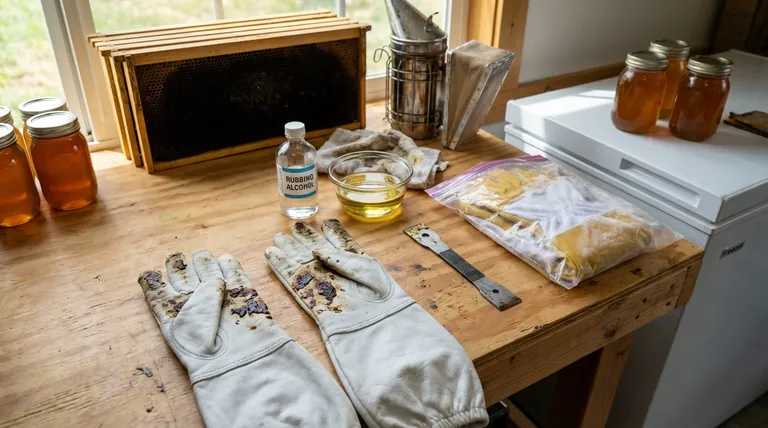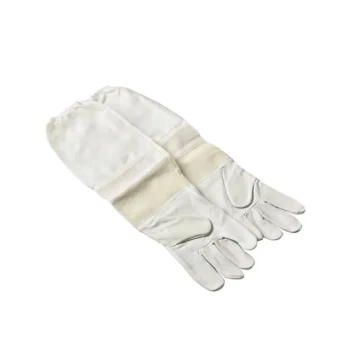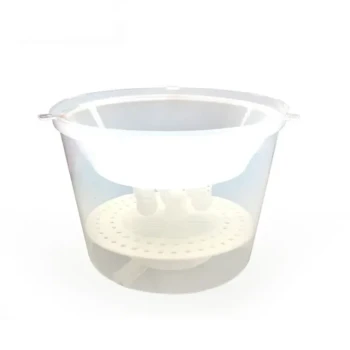To effectively remove propolis, you have two primary methods depending on the severity and glove material. You can either freeze the gloves to make the propolis brittle enough to scrape off, or use a solvent like rubbing alcohol or vegetable oil to dissolve the sticky resin before washing.
The most effective strategy for removing propolis is not a single trick, but a two-step process: first, physically remove as much as possible, then chemically dissolve the remaining residue. The right technique depends entirely on your glove material and the thickness of the propolis buildup.

The Core Removal Techniques Explained
Propolis is a plant resin, and its removal requires breaking it down either physically or chemically. Understanding how each method works will help you choose the most appropriate one for your situation.
Method 1: The Freezing Technique
The goal of freezing is to change the physical state of the propolis. When cooled to freezing temperatures, the sticky, pliable resin becomes hard and brittle.
Place your gloves in a plastic bag and leave them in a freezer for several hours. Once frozen solid, remove the gloves and immediately begin to crack and flake off the hardened propolis.
A hive tool or a blunt knife works well for scraping away the larger, now-brittle pieces. This method is excellent for thick, heavy layers of propolis.
Method 2: Using Solvents
Solvents work by chemically dissolving the propolis resin, breaking down its sticky structure. This is best for thin layers or final cleanup after scraping.
For rubber, nitrile, or synthetic gloves, rubbing alcohol (isopropyl alcohol) is a powerful and effective solvent. Apply it to a cloth and rub the propolis until it dissolves.
For leather gloves, a less harsh option like vegetable oil is preferable. The oil helps break down the propolis without drying out the leather. Rub the oil into the sticky areas, let it sit, and then wipe away the residue.
Choosing the Right Method for Your Gloves
The material of your gloves is the single most important factor in choosing a cleaning method. Using the wrong technique can cause irreversible damage.
For Leather Gloves
Leather is a natural material that can easily dry out, crack, or become stiff. Harsh chemicals and extreme temperature changes pose a risk.
Always start with the gentlest method. Begin by scraping what you can, then use vegetable oil to dissolve the sticky residue. Afterwards, wash with a mild soap (like saddle soap) and water, and finish with a leather conditioner to restore flexibility.
For Rubber or Nitrile Gloves
Synthetic materials are far more resilient to chemicals. You can safely use the freezing method for heavy buildup.
For any remaining stickiness, rubbing alcohol is the most efficient solvent. It will quickly dissolve the propolis without harming the material. Simply wash with soap and water afterwards.
Understanding the Trade-offs
No method is perfect, and each comes with potential downsides. Being aware of them will prevent you from damaging your equipment.
The Risk of Damaging Leather
Freezing can make old or dry leather brittle, potentially causing it to crack along with the propolis. Similarly, alcohol is extremely dehydrating and will strip the natural oils from leather, leading to stiffness and cracking. Never use alcohol on leather gloves.
The Inefficiency of Solvents on Heavy Buildup
Trying to dissolve thick, caked-on propolis with alcohol or oil is inefficient and time-consuming. It is far more effective to first remove the bulk of the material by freezing and scraping it off. Solvents are best reserved for the thin, sticky film left behind.
The Post-Cleaning Wash is Critical
Both oil and alcohol leave behind a residue that must be cleaned off. After any propolis treatment, always wash your gloves with a mild detergent and water to remove any remaining solvent and dissolved resin.
A Final, Actionable Protocol
Follow these steps for a complete cleaning process that preserves the life of your gloves.
- Initial Scraping: Use a hive tool to gently scrape off any excess wax and propolis before treatment.
- Propolis Treatment: Choose your method—freezing for bulk removal or solvents for thin residue, always prioritizing the safety of your glove material.
- Washing: After treatment, wash the gloves with lukewarm water and a mild detergent to remove all residues.
- Drying & Conditioning: Air dry the gloves completely, away from direct heat. If they are leather, apply a quality leather conditioner once dry to maintain their suppleness.
How to Apply This to Your Goal
- If your primary focus is removing heavy buildup on any glove type: Start by freezing the gloves to make the propolis brittle, then scrape it off.
- If your primary focus is cleaning thin, sticky residue from synthetic gloves: Use a cloth dampened with rubbing alcohol to dissolve the film quickly.
- If your primary focus is safely cleaning expensive leather gloves: Gently scrape, then use vegetable oil and a cloth to remove residue before washing with saddle soap and applying a conditioner.
Properly maintaining your gear is a cornerstone of responsible and effective beekeeping.
Summary Table:
| Glove Material | Primary Method | Best Solvent | Key Consideration |
|---|---|---|---|
| Leather Gloves | Gentle Scraping | Vegetable Oil | Avoid harsh chemicals and extreme cold to prevent cracking. |
| Rubber/Nitrile Gloves | Freezing & Scraping | Rubbing Alcohol | Resilient to chemicals; effective for heavy buildup. |
Keep your beekeeping operations running smoothly with the right gear. HONESTBEE supplies durable beekeeping gloves and equipment to commercial apiaries and distributors through our wholesale-focused operations. Ensure your team is equipped with reliable, easy-to-maintain gear. Contact us today to discuss your supply needs!
Visual Guide

Related Products
- Beekeeping Gloves Goatskin Leather with Long Cotton Sleeve for Beekeepers
- Goatskin Leather Beekeeper Gloves with Vent Long Sleeve for Beekeeping Honey Bee Sting Proof Protection
- Goat Skin Leather Bee Sting Proof Beekeeping Gloves with Canvas Sleeve
- Mesh Ventilated 3 Layer Goatskin Beekeepers Gloves for Beekeeping
- Professional Grade Foldable Beehive Handles
People Also Ask
- What are the arguments for and against using gloves in beekeeping? Balancing Protection and Dexterity
- What are the features of ventilated bee gloves? Stay Cool & Dexterous in Warm Weather
- Why do some experienced beekeepers choose not to wear gloves? For Superior Dexterity & Hive Welfare
- What should beekeepers consider regarding the fit of beekeeping gloves? Achieve Safety and Dexterity
- Why are protective gloves important in beekeeping? Boost Confidence & Safety in Your Apiary



















